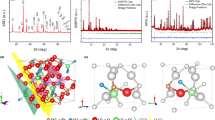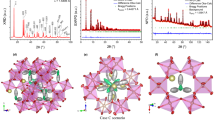Abstract
FROM thermal analyses, Guertler1 concluded that bismuth trioxide, Bi2O3, existed in two forms, one stable above 704° C. and one stable below this temperature. He was not able to prepare the high-temperature modification even by quenching.
This is a preview of subscription content, access via your institution
Access options
Subscribe to this journal
Receive 51 print issues and online access
$199.00 per year
only $3.90 per issue
Buy this article
- Purchase on Springer Link
- Instant access to full article PDF
Prices may be subject to local taxes which are calculated during checkout
Similar content being viewed by others
References
Guertler, W., Z. anorg. Chem., 37, 222 (1903).
Sillén, L. G., Ark. Kemi, Min. Geol., 12, A, No. 18 (1937): and Diss. Stockholm (1940).
Schumb, W., and Rittner, E., J. Amer. Chem. Soc., 65, 1055 (1943).
Author information
Authors and Affiliations
Rights and permissions
About this article
Cite this article
AURIVILLIUS, B., SILLÉN, L. Polymorphy of Bismuth Trioxide. Nature 155, 305–306 (1945). https://doi.org/10.1038/155305a0
Issue Date:
DOI: https://doi.org/10.1038/155305a0
This article is cited by
-
Bi4Ti3O12 electroceramics: effect of doping, crystal structure mechanisms and piezoelectric response
Journal of the Korean Ceramic Society (2023)
-
Structural, Spectroscopic Studies and Magnetic Properties of Doped Sillenites-Type Oxide Bi12[M]O20 M=Fe, Co
Journal of Superconductivity and Novel Magnetism (2013)
-
Effect of ionic polarizability on oxygen diffusion in δ-Bi2O3 from atomistic simulation
Ionics (2010)
-
The bismuth-oxygen system
Journal of Phase Equilibria (1995)
-
Characterization of bismuth lead oxide by vibrational spectroscopy
Journal of Materials Science (1995)
Comments
By submitting a comment you agree to abide by our Terms and Community Guidelines. If you find something abusive or that does not comply with our terms or guidelines please flag it as inappropriate.



